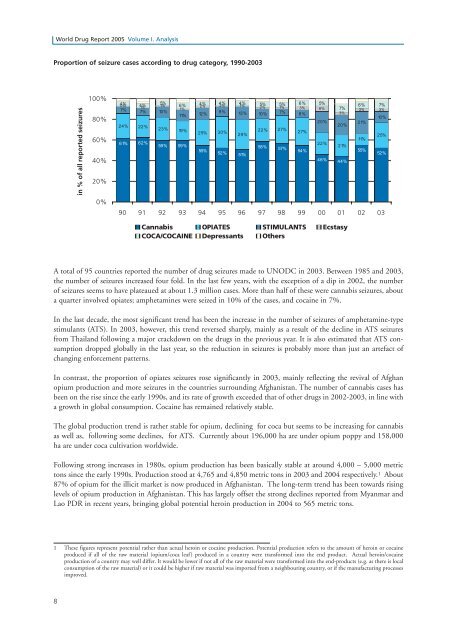World Drug Report 2005 - United Nations Office on Drugs and Crime
World Drug Report 2005 - United Nations Office on Drugs and Crime
World Drug Report 2005 - United Nations Office on Drugs and Crime
Create successful ePaper yourself
Turn your PDF publications into a flip-book with our unique Google optimized e-Paper software.
<str<strong>on</strong>g>World</str<strong>on</strong>g> <str<strong>on</strong>g>Drug</str<strong>on</strong>g> <str<strong>on</strong>g>Report</str<strong>on</strong>g> <str<strong>on</strong>g>2005</str<strong>on</strong>g> Volume I. Analysis<br />
Proporti<strong>on</strong> of seizure cases according to drug category, 1990-2003<br />
in % of all reported seizures<br />
100%<br />
80%<br />
60%<br />
40%<br />
20%<br />
0%<br />
4% 0% 4%<br />
5%<br />
1%<br />
1%<br />
7% 7% 10 %<br />
24% 22%<br />
61% 62%<br />
23% 19 %<br />
59% 59%<br />
6% 4% 4% 4%<br />
2% 2% 1% 5% 5% 6% 5%<br />
1%<br />
2% 1% 3% 6%<br />
11% 12 %<br />
9% 13 % 10 % 7% 8%<br />
25% 30%<br />
55%<br />
29%<br />
52% 51%<br />
22% 27%<br />
58% 57%<br />
27%<br />
54%<br />
20%<br />
22%<br />
7%<br />
3%<br />
20%<br />
21%<br />
46% 44%<br />
6% 7%<br />
3% 3%<br />
90 91 92 93 94 95 96 97 98 99 00 01 02 03<br />
Cannabis OPIATES STIMULANTS Ecstasy<br />
COCA/COCAINE Depressants Others<br />
21%<br />
11%<br />
55%<br />
10 %<br />
25%<br />
52%<br />
A total of 95 countries reported the number of drug seizures made to UNODC in 2003. Between 1985 <strong>and</strong> 2003,<br />
the number of seizures increased four fold. In the last few years, with the excepti<strong>on</strong> of a dip in 2002, the number<br />
of seizures seems to have plateaued at about 1.3 milli<strong>on</strong> cases. More than half of these were cannabis seizures, about<br />
a quarter involved opiates; amphetamines were seized in 10% of the cases, <strong>and</strong> cocaine in 7%.<br />
In the last decade, the most significant trend has been the increase in the number of seizures of amphetamine-type<br />
stimulants (ATS). In 2003, however, this trend reversed sharply, mainly as a result of the decline in ATS seizures<br />
from Thail<strong>and</strong> following a major crackdown <strong>on</strong> the drugs in the previous year. It is also estimated that ATS c<strong>on</strong>sumpti<strong>on</strong><br />
dropped globally in the last year, so the reducti<strong>on</strong> in seizures is probably more than just an artefact of<br />
changing enforcement patterns.<br />
In c<strong>on</strong>trast, the proporti<strong>on</strong> of opiates seizures rose significantly in 2003, mainly reflecting the revival of Afghan<br />
opium producti<strong>on</strong> <strong>and</strong> more seizures in the countries surrounding Afghanistan. The number of cannabis cases has<br />
been <strong>on</strong> the rise since the early 1990s, <strong>and</strong> its rate of growth exceeded that of other drugs in 2002-2003, in line with<br />
a growth in global c<strong>on</strong>sumpti<strong>on</strong>. Cocaine has remained relatively stable.<br />
The global producti<strong>on</strong> trend is rather stable for opium, declining for coca but seems to be increasing for cannabis<br />
as well as, following some declines, for ATS. Currently about 196,000 ha are under opium poppy <strong>and</strong> 158,000<br />
ha are under coca cultivati<strong>on</strong> worldwide.<br />
Following str<strong>on</strong>g increases in 1980s, opium producti<strong>on</strong> has been basically stable at around 4,000 – 5,000 metric<br />
t<strong>on</strong>s since the early 1990s. Producti<strong>on</strong> stood at 4,765 <strong>and</strong> 4,850 metric t<strong>on</strong>s in 2003 <strong>and</strong> 2004 respectively. 1 About<br />
87% of opium for the illicit market is now produced in Afghanistan. The l<strong>on</strong>g-term trend has been towards rising<br />
levels of opium producti<strong>on</strong> in Afghanistan. This has largely offset the str<strong>on</strong>g declines reported from Myanmar <strong>and</strong><br />
Lao PDR in recent years, bringing global potential heroin producti<strong>on</strong> in 2004 to 565 metric t<strong>on</strong>s.<br />
1 These figures represent potential rather than actual heroin or cocaine producti<strong>on</strong>. Potential producti<strong>on</strong> refers to the amount of heroin or cocaine<br />
produced if all of the raw material (opium/coca leaf) produced in a country were transformed into the end product. Actual heroin/cocaine<br />
producti<strong>on</strong> of a country may well differ. It would be lower if not all of the raw material were transformed into the end-products (e.g. as there is local<br />
c<strong>on</strong>sumpti<strong>on</strong> of the raw material) or it could be higher if raw material was imported from a neighbouring country, or if the manufacturing processes<br />
improved.<br />
8

















